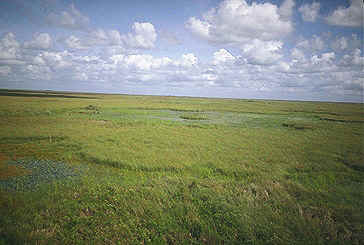Lesson 5

Title: Comparing and Contrasting Florida Everglades to other Wetlands
Objective:
The students will be able to identify qualities that are unique to the Florida Everglades they will also be able to identify ways in which they are similar to other wetland regions.
Materials:
- Everglades Journal
- Venn diagram
Activities:
- Discuss as a class the Florida Everglades. Use
Everglades Journals and their entries to
share ideas of what the Everglades is like. Then discuss other wetlands.
- Have students visit the following web sites to gather information on other
wetlands.
- Topics
What is a wetland?
Wetland is an area of land where the water level remains near or
above the surface of the ground for most of the year.
What are the major types of wetlands?
The major types of wetlands include bogs, fens, marshes, and
swamps.
What kinds of animals inhabit wetlands?
Many kinds of animals inhabit wetlands. They include a wide
variety of birds and insects; amphibians, such as frogs and
salamanders; and such reptiles as alligators, snakes, and turtles.
Mammals including beavers, muskrats, panthers, deer, and otters,
also live in wetlands.
What role does a wetland play in nature?
In addition to being a habitat for many plants and
animals--particularly many endangered species--wetlands help to
control flooding because they retain large amounts of water. The
water stored by wetlands also serves as a source of replenishment
for ground water supplies. In addition, people use wetlands for
fishing, hunting, and nature study.
- Have students do a search on their own to discover web sites that detail other wetlands. They can use the following search engines to assist in the search:
Alta Vista,
Yahooligans, and Google.
Use search words such as Everglades, marsh, wetlands, mangrove,
coastal ecosystem
- Students should make entries in their journal as they are making discoveries at the various sites.
- The students will use the information gathered to complete a Venn Diagram. They will compare The Florida Everglades to another
wetland.
- Students will then identify and
name other wetlands on a US map.
Evaluation:
Students will be evaluated on
completed Venn Diagram for content and accuracy.
Extension: Endangered Animals
Database
- Define the word endangered-
threatened with extinction
- Students will research the
endangered Florida panther using Florida
Wildlife and Florida-
Panther
- Environmentalists have had tunnels
build under busy highways to help save Florida panthers; many have
been killed by cars. Officials say that now many animals use the
tunnels to keep safe: panthers, bobcats, and raccoons.
- Open ended question: What other
things can people do besides building tunnels to save Florida
panthers?
- Research other endangered species at Ed
Net- Endangered Species
- Open the database application in a word processing software
- Create a field for the names of Endangered Animals (examples-
cheetah, tiger, brown bear, bobcat, leopard, mountain zebra, ocelot,
California condor, Florida panther)
- Create a field for why they are endangered (loss of habitat, pollution,
over hunting or fishing...)
- Create a field of where the animal lives
- Proofread, spell check, print
- Share with class
- Locate where animal lives on world map at Altapedia
- Open ended question: What things people can do to help save
endangered animals?
Homework:
Have student go to the library to find trade books on the
Everglades or other wetlands. Students will prepare a book report about the
Everglades. This can be in the format of
Synonym Strips. Synonym strips are designed to help students expand
their vocabularies.
- Students will find four or more
sentences in a book that contain words unfamiliar to them.
- Copy each sentence and its page.
Underline the unknown word in each sentence. Cut each strip along
the dotted lines.
- Look up each unknown word in a
thesaurus; there is one on your computer. Select four of more synonyms
for each unknown word. Copy the synonyms on the back of each strip
- Read the sentence on the front of
the strip, replacing the underlined word with one of the synonyms.
Repeat until you have read the sentence with each synonym.

